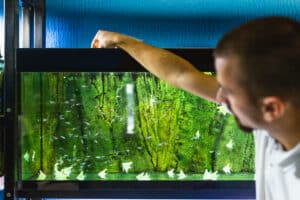Are you thinking about drilling a hole in your tempered glass aquarium but want to know if it’s safe to do so? Then you’re at the right place!
Drilling tempered glass aquariums are usually not recommended due to the potential for breaking or shattering the glass. Tempered glass is stronger than regular glass but is also more brittle and can be prone to breaking under stress or impact.
That said, you can drill it using a particular procedure of annealing the tempered glass and removing its temper.
Read on to learn the signs to know you have a tempered glass aquarium, what tempered glass is, and the right way to drill it.
How To Determine If Your Aquarium Glass Is Tempered?
#1. Look For A Label Or Markings On The Glass:
Some manufacturers will include labels or markings on the glass to indicate that it is tempered. This may include a sticker or an etched marking on the glass. You can check the edges of the glass or the corners for these markings.
#2. Check The Edges Of The Glass:
The edges of tempered glass are usually smooth and have a polished finish, while the edges of the regular glass are often rough and have a raw, unfinished appearance. You can examine the edges of the glass to see if they are smooth and polished or rough and unfinished.
#3. Look For Imperfections
When examining tempered glass, it is common to see small imperfections on the surface of the glass.
To determine if a piece of glass is tempered, you can look for these imperfections and compare them to known examples of tempered glass.
If you notice any unusual or excessive imperfections in the glass, or if you see any distortions or slight bending in the glass, the glass is likely tempered.
These imperfections are often a result of the intense heating process that is used to temper the glass.
When the glass is heated to a high temperature, it becomes more pliable and can be shaped or molded.
However, the process of picking up the hot glass using tongs or other tools can leave slight imperfections on the surface of the glass.
#4. Inspect The Glass By Wearing Polarized Sunglasses
To determine if a piece of glass is tempered, use polarized glasses while viewing the glass in the sunlight.
Polarized glasses have special lenses coated with a film that helps reduce glare and improve contrast.
When you view the glass through the sunglasses, you may see small imperfections or defects on the glass surface that are not visible to normal eyes.
If you notice shadowy lines or spots on the glass, it is likely tempered glass.
These lines or spots are usually caused by the machine rollers that go over the glass during the tempering process, leaving small imperfections behind.
Read: Can You Keep Fish Tanks Near Windows?
What Is Tempered Glass?
Tempered glass is a special safety glass that is treated with a special heat-treatment process to make it stronger and more durable than regular glass.
It is often used in applications where safety is a concern, such as in car windows, shower doors, and aquariums.
While tempered glass is stronger and more resistant to breaking than regular glass, it is also more brittle.
Tempered glass is around four times stronger than regular glass, but it is also made such that it can shatter when subjected to impact.
In general, the tempered glass is likely to shatter before the user can even complete the hole, making it very hard to drill through tempered glass.
Additionally, drilling a hole in an aquarium can impact the glass’s structural integrity. It may weaken it, making it more prone to breaking or shattering in the long run.
Check Out: Should You Have An Open Or Closed Fish Tank?
How You Can Drill A Hole In Tempered Glass?

To minimize the risk of breaking or shattering the glass, the proper way to drill tempered glass is first to anneal it or heat it to a high temperature to remove the temper.
Once the glass has been annealed, it can be drilled in a non-tempered state. After the hole has been drilled, the glass can then be re-tempered or heated to a high temperature and cooled to give it strength and durability.
Here’s a general overview of the process of annealing and drilling a hole in tempered glass:
- Heat the glass to a high temperature: To anneal the glass, it must be heated to a high temperature, typically around 1000 degrees Fahrenheit. This can be done using a specialized oven or furnace designed for this purpose.
- Allow the glass to cool slowly: Once it has been heated to the appropriate temperature, it must be allowed to cool slowly. This process is known as “annealing” and helps remove the glass’s temper, making it less brittle and more resistant to breaking or shattering.
- Secure the glass: Once it has been annealed, it must be securely held while drilling. This can be done using clamps, blocks, or other specialized equipment to hold the glass securely.
- Drill the hole: Once the glass is securely held, a hole can be drilled using a specialized drill bit or rotary tool with a diamond blade. Again, it is important to apply steady and even pressure.
- Re-temper the glass: After the hole has been drilled, the glass can be re-tempered or heated to a high temperature and cooled rapidly. This process helps to restore the strength and durability of the glass and helps to ensure that it will not break or shatter when subjected to stress or impact.
- Clean and finish the hole: Once the glass has been re-tempered, it is important to clean and finish the hole as needed. This may include removing any burrs or rough edges around the hole, smoothing the edges, and applying any necessary sealants or adhesives.
Read: Can You Put A Fish Tank Under A TV?
Wrapping Up
Drilling a hole in a tempered glass aquarium can be challenging due to the risk of breaking or shattering the glass.
While it is generally not recommended to drill tempered glass aquariums, you can drill it by annealing the glass, drilling the hole while the glass is no longer tempered, and re-temper the glass after the hole has been drilled.
Additionally, it is important to take proper safety precautions when working with tempered glass, such as wearing protective eyewear and gloves and keeping any animals or people out of the area while working.
Additional Resources That Might Help You:
Hi! I’m Praveen Ghoshal, the founder of eFishkeeping.com. Inspired by my Dad, I got interested in fishkeeping when I was a kid. Since then, I have been involved with this hobby. Currently, I have 3 fish tanks at our home, and I enjoy this hobby with my full family. Read more about me here.








